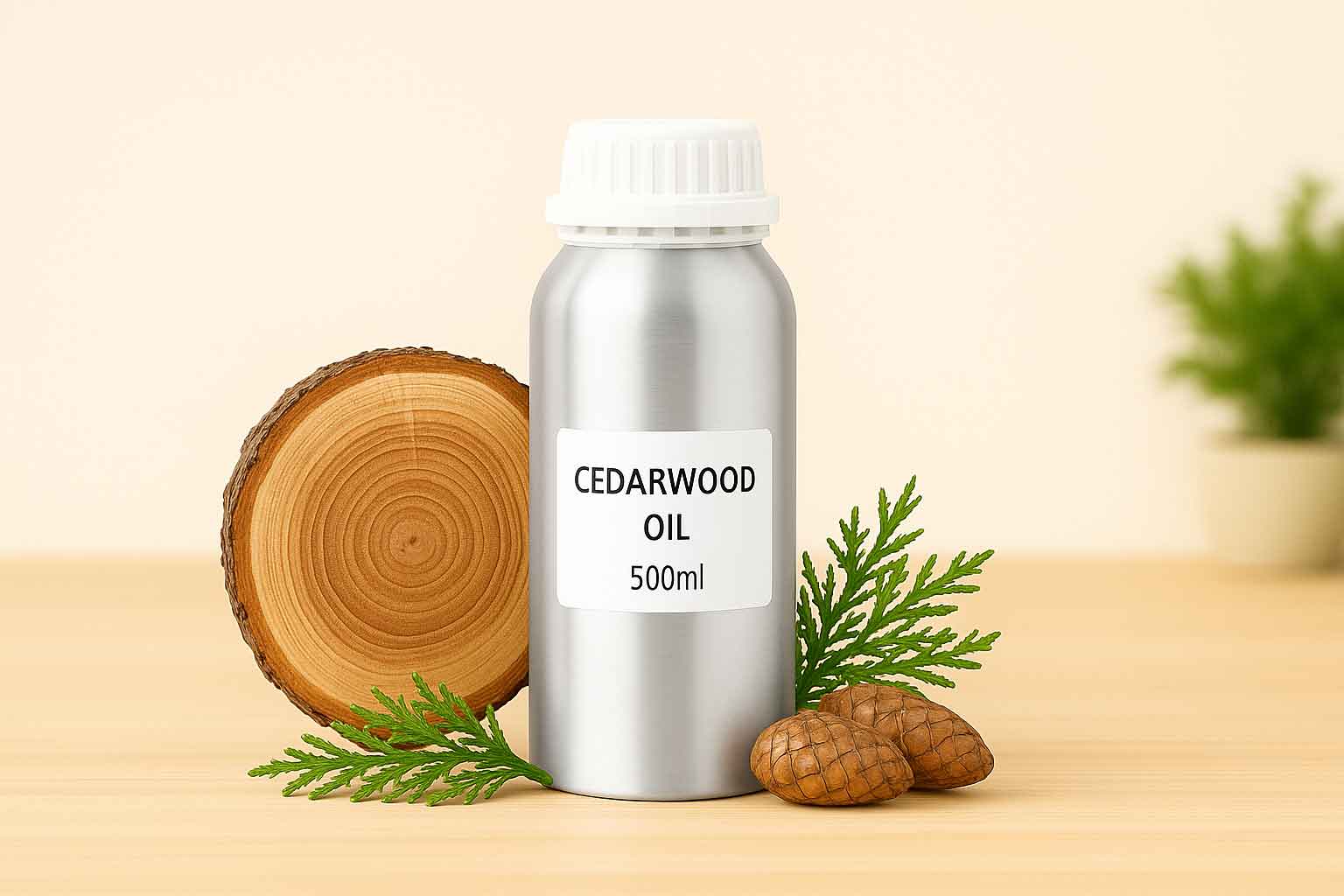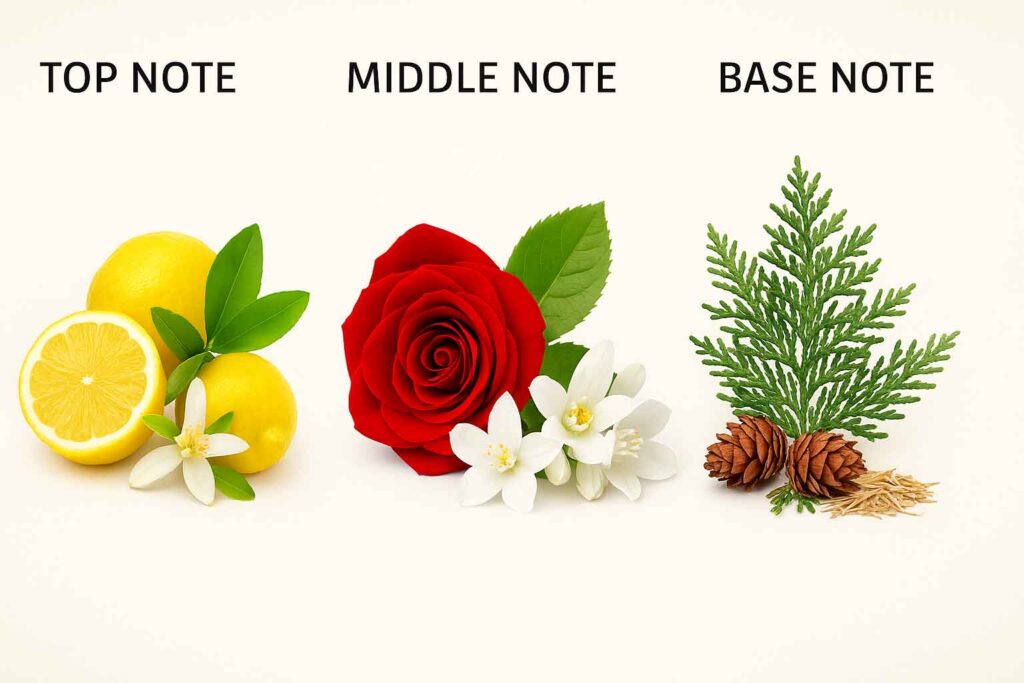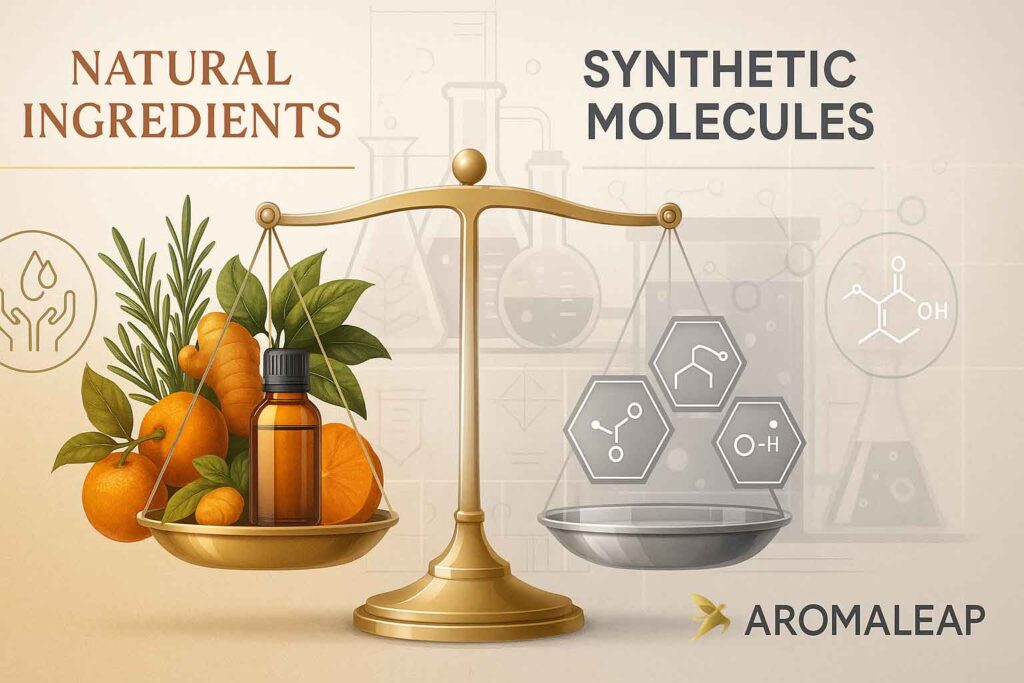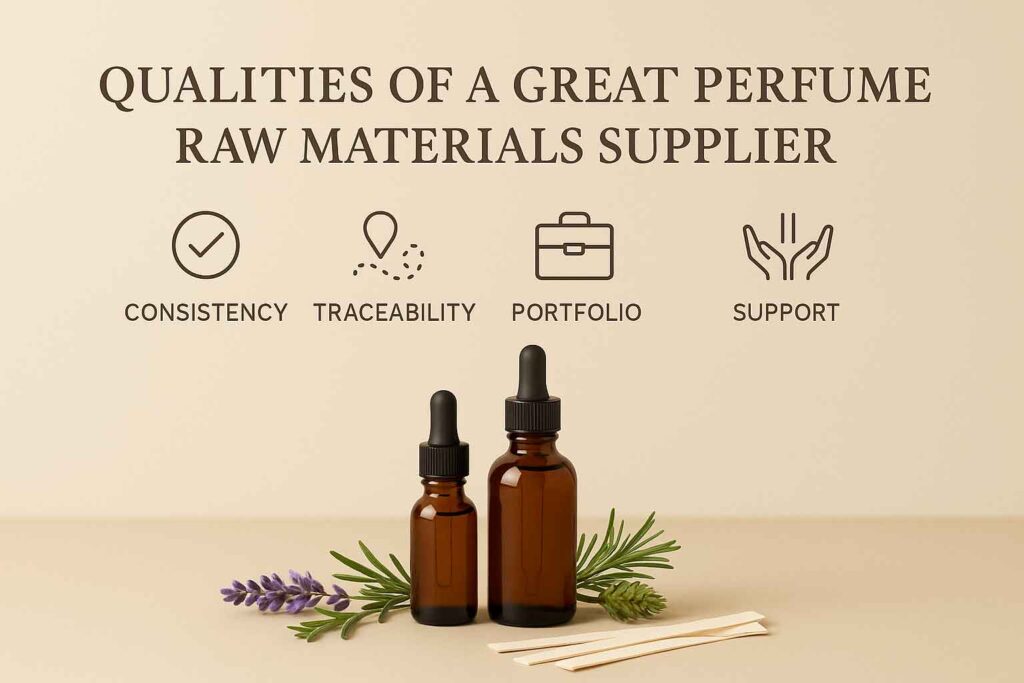
Dive Into Perfume Fragrance Ingredients-What Wholesale Buyers Must Know
- May 15, 2025
Table of Contents
Introduction
At AromaLeap, we create every drop of fragrance oil resulting from meticulous craftsmanship, deep industry knowledge, and a genuine passion for perfumery. In today’s dynamic fragrance market, wholesale buyers seek more than just a list of perfume ingredients- they want transparency, reliability, and innovation from their raw materials supplier.
Having worked closely with perfumers, brand owners, and R&D teams worldwide, we’ve seen firsthand how the right perfume raw materials can transform a fragrance from ordinary to unforgettable. The foundation of your fragrance always starts with the right building blocks. Suppose you’re searching for natural ingredients for perfume, advanced aromatic compounds. In this article, I’ll share insights from our daily work at AromaLeap, highlight the essential perfume fragrance ingredients that shape every successful scent, and provide practical guidance for wholesale buyers who demand the best for their brands.
The Building Blocks of Perfume: Key Ingredient Categories
Every memorable fragrance is a harmonious blend of carefully selected ingredients, each playing a distinct role in the overall composition. At AromaLeap, we approach perfume creation much like an architect approaches a blueprint- balancing artistry with precision, and always with the customer’s vision in mind.
The Perfume Pyramid: Structure and Function
Fragrances are typically structured in three layers: top notes, heart (middle) notes, and base notes. Each layer comprises specific perfume raw materials, chosen for their volatility, olfactory impact, and synergy with other ingredients.
| Note Layer | Typical Longevity | Common Ingredients (Examples) | Key Functions |
|---|---|---|---|
| Top Notes | 5–15 minutes | Bergamot oil, lemon oil, aldehydes, mint | First impression, freshness |
| Heart Notes | 20–60 minutes | Rose absolute, jasmine, hedione, methyl ionone | Signature character, complexity |
| Base Notes | 2–6 hours+ | Vetiver, sandalwood, ambroxan, benzoin, musks | Depth, longevity, fixation |
Top Notes:
These are the first to greet the senses and set the stage for the fragrance experience. Our facility often uses a blend of natural citrus oils, green notes, and select aldehydes-aromatic compounds prized for their uplifting brightness. The quality and purity of these ingredients are critical, as they form the initial impression for your customers.
Heart Notes:
The heart, or middle notes, define the fragrance’s personality. This is where floral perfume ingredients such as rose absolute, jasmine, and orange blossom shine, supported by sophisticated synthetics like hedione and methyl ionone. Our perfumers carefully balance these elements to ensure the scent remains vibrant and memorable as it evolves.
Base Notes:
Finally, the base notes anchor the fragrance, providing depth and lasting power. Here, we incorporate oil perfume ingredients such as vetiver, sandalwood, labdanum, and modern fixatives like ambroxan and musks. These ingredients enhance longevity and ensure batch consistency, which is essential for any wholesale buyer.
Why Ingredient Selection Matters
Selecting the right perfume raw materials isn’t just about following a formula. It’s about understanding how each component, whether a rare essential oil or a high-purity synthetic, will interact, perform, and ultimately delight your end customers. At AromaLeap, we invest in rigorous quality control and technical documentation so that you can be confident in every batch.
In the next section, I’ll delve deeper into the essential fragrance ingredients every wholesale buyer should know and how to leverage natural and synthetic options for market success.

Essential Perfume Fragrance Ingredients for Wholesale Buyers
Selecting the right fragrance ingredients is both a science and an art. At AromaLeap, our daily work with global clients has shown that the most successful brands understand what’s trending and what truly performs in their target markets. Below, I’ll break down the most important perfume raw materials that every wholesale buyer should consider, drawing from our ingredient portfolio and industry experience.
Top Notes: The Spark of First Impressions
Top notes are the introduction to your fragrance. They are often lively, volatile, and set the mood for what’s to come.
Common Ingredients:
Citrus Oils: Bergamot, lemon, orange (natural ingredients for perfume that deliver a crisp, clean opening)
Aldehydes: Aldehyde C14, Aldehyde C18 (aromatic compounds that add a sparkling, modern twist)
Green & Herbal Notes: Galbanum, mint, lavender (oil perfume ingredients that impart freshness)
Industry Insight:
In our factory, we’ve noticed that blends featuring a balance of citrus oils and aldehydes consistently score higher in consumer testing for “freshness” and “cleanliness”-attributes highly sought after in both fine fragrance and personal care.
Heart (Middle) Notes: The Signature Character
Heart notes form the core of your fragrance, lasting longer and giving the scent its unique personality.
Common Ingredients:
Floral Perfume Ingredients: Rose absolute, jasmine, orange blossom, lily, violet (classic and modern floral signatures)
Spices & Fruits: Clove, cinnamon, peach, cassis (add warmth and complexity)
Specialty Synthetics: Hedione, methyl ionone gamma (enhance diffusion and longevity)
Factory Perspective:
Our R&D team often works with combinations of natural absolutes and specialty synthetics. For example, a rose absolute and hedione blend can elevate a floral heart, making it timeless and contemporary, a favorite among niche brands.
Base Notes: The Foundation of Longevity
Base notes are the backbone of your fragrance, responsible for its lasting impression and depth.
Common Ingredients:
Woody & Resinous: Vetiver, sandalwood, benzoin, labdanum (provide richness and depth)
Musks & Ambers: Ambroxan, ISO E Super, galaxolide, habanolide (synthetic fragrance molecules that ensure longevity and sillage)
Fixatives: Essential for batch consistency and regulatory compliance
Market Data Table: Most Requested Base Ingredients (2024, AromaLeap Wholesale Orders)
| Ingredient | Natural/Synthetic | % of Orders | Typical Use |
|---|---|---|---|
| Ambroxan | Synthetic | 68% | Modern amber/woody |
| Vetiver Oil | Natural | 54% | Woody, earthy bases |
| Sandalwood Oil | Natural | 49% | Creamy, soft bases |
| ISO E Super | Synthetic | 45% | Transparent woods |
| Benzoin | Natural | 32% | Sweet, balsamic |
Expert Note:
Ambroxan and ISO E Super have become industry standards for brands seeking a contemporary, long-lasting effect. However, natural sandalwood and vetiver remain in high demand for luxury and “clean label” product lines.
Natural vs. Synthetic: Sourcing the Right Perfume Raw Materials
One of the most frequent questions we receive from wholesale buyers is whether to focus on natural ingredients for perfume or embrace the advantages of modern synthetics. The answer is almost always a thoughtful combination of both.
Natural Ingredients for Perfume
Advantages:
Authenticity and consumer appeal (“clean beauty” trend)
Rich, nuanced olfactory profiles (e.g., essential oils, absolutes)
Storytelling potential for marketing
Considerations:
Batch consistency can vary due to harvest conditions
Higher cost and supply limitations
Synthetic Fragrance Molecules and Aromatic Compounds
Advantages:
Batch consistency and scalability (critical for large-volume buyers)
Creative flexibility (unique notes not found in nature)
Enhanced stability and regulatory control
Key Examples:
Ambroxan, ISO E Super, hedione, methyl ionone, galaxolide
What Are Aromatic Compounds?
Aromatic compounds are natural or synthetic molecules that provide distinct olfactory effects. In our company, we use both traditional and cutting-edge aromatic compounds to create fragrances that are not only beautiful but also stable and compliant with international regulations.
Sourcing Best Practices
At AromaLeap, transparency is non-negotiable. Every batch of perfume raw materials comes with full technical documentation, including Certificates of Analysis (COA) and Material Safety Data Sheets (MSDS). This ensures you receive exactly what you order, every time.
Quick Checklist for Wholesale Buyers:
– Request both natural and synthetic options for your perfume ingredients list
– Verify batch consistency and regulatory compliance
– Consider market trends: “clean label” for naturals, performance for synthetics
– Partner with a perfume raw materials supplier who can provide both flexibility and expertise
In the next section, I’ll share how to choose the right supplier and what practical steps you can take to ensure your fragrance products stand out in a competitive marketplace.

Selecting a Perfume Raw Materials Supplier: What Wholesale Buyers Should Look For
Choosing the right perfume raw materials supplier is a pivotal decision that can shape your brand’s reputation, product quality, and long-term growth. At AromaLeap, we’ve seen how partnerships built on transparency and technical excellence empower our clients to innovate confidently and scale with peace of mind.
What Makes a Great Supplier Apart?
1. Comprehensive Ingredient Portfolio
Look for a supplier who can provide a complete perfume ingredients list, including natural ingredients for perfume (essential oils, absolutes, oil perfume ingredients) and advanced synthetic fragrance molecules (ambroxan, ISO E Super, hedione, methyl ionone). This flexibility allows you to tailor your formulations for different markets and price points.
2. Ingredient Traceability & Technical Documentation
A professional supplier should offer full traceability for every batch and technical documentation such as COA (Certificate of Analysis) and MSDS (Material Safety Data Sheet). This is essential for regulatory compliance and consumer trust.
3. Batch Consistency & Quality Control
Consistency is non-negotiable for any perfume manufacturer or brand. AromaLeap employs rigorous quality control protocols, including GC-MS analysis and sensory evaluation, to ensure every delivery matches your specifications.
4. Market Understanding & Customer Support
A supplier who understands evolving market trends (such as the demand for floral perfume ingredients, “clean label” products, and sustainable sourcing) can help you stay ahead of the curve. Responsive customer support and technical guidance are invaluable, especially when developing new products or troubleshooting formulation challenges.
5. Logistics & Scalability
Timely delivery, scalable production, and flexible packaging options are critical for wholesale buyers. Whether you need small pilot batches or full-scale production, your supplier should be equipped to grow with your business.
Supplier Evaluation Table
| Criteria | Why It Matters | AromaLeap’s Approach |
|---|---|---|
| Ingredient Range | Enables creative, market-driven blends | 500+ natural & synthetic options |
| Traceability & Documentation | Regulatory compliance & transparency | COA, MSDS |
| Batch Consistency | Reliable product performance | Advanced QC, sensory panels |
| Market Insight | Competitive advantage | Trend analysis, R&D collaboration |
| Logistics & Scalability | Business continuity | Global shipping, flexible MOQs |

Practical Tips for Wholesale Buyers
Having worked with hundreds of fragrance brands, I’ve gathered some practical strategies that can help you maximise value and minimise risk when sourcing fragrance ingredients:
1. Request Samples and Pilot Batches
Before committing to large orders, always request samples of your chosen perfume raw materials. Evaluate them in your lab or with your perfumer to ensure they meet your aroma, performance, and stability expectations.
2. Build a Versatile Ingredients Library
Maintain a working list of perfume ingredients covering core essentials (like sandalwood, vetiver, benzoin) and trending aromatic compounds. This allows you to respond quickly to market shifts and client requests.
3. Prioritize Documentation and Compliance
Keep all technical documentation organised and up-to-date. This streamlines regulatory audits and reassures your customers about safety and quality.
4. Stay Informed on Market Trends
Regularly review market data and consumer insights. For example, in 2024, we’ve seen a 30% increase in demand for natural ingredients for perfume and a growing interest in sustainable, traceable sourcing.
5. Cultivate a True Partnership
Work with a supplier who sees themselves as an extension of your team. At AromaLeap, we offer products, ongoing support, formulation advice, and market intelligence to help your business thrive.
Conclusion
Success in the fragrance industry begins with the right ingredients and partners. You can craft fragrances that resonate with today’s discerning consumers by understanding the full spectrum of perfume raw materials- from natural absolutes and essential oils to innovative aromatic compounds.
At AromaLeap, we’re passionate about helping brands unlock their creative potential through a world-class selection of fragrance ingredients, rigorous quality standards, and a collaborative approach to every project. Whether developing a signature scent or scaling a global product line, we support your vision with expertise, warmth, and unwavering professionalism.
Ready to elevate your brand? Please explore our complete perfume ingredients list, request samples, or speak with our team about your next project. Let’s create something extraordinary together.
